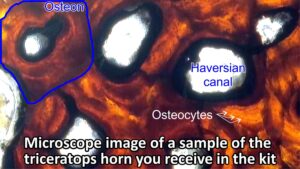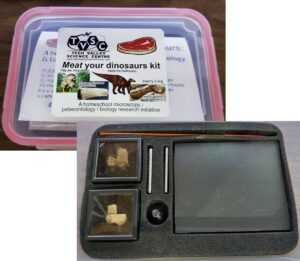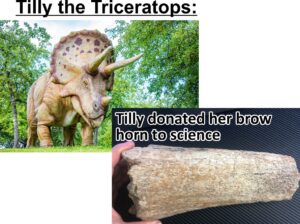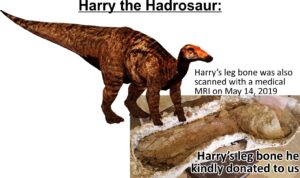Meat your dinosaurs! Home paleontology & microscopy classes
 Alright here we go: the Meat your dinosaurs kit is now available. The kit will include lifetime access to three online classes which you can follow on your own schedule. Designed for ages 8 and up, you will get two fossil dinosaur bone or horn samples which you will mount on a microscope slide and cut down to a thin section. You will then study the dinosaurian samples to learn and study bone structure and maybe, hopefully, you might even see some things like bone cells and dinosaur blood. Who knows – you might even find dinosaur meat just like what has been found by scientists on several occasions.
Alright here we go: the Meat your dinosaurs kit is now available. The kit will include lifetime access to three online classes which you can follow on your own schedule. Designed for ages 8 and up, you will get two fossil dinosaur bone or horn samples which you will mount on a microscope slide and cut down to a thin section. You will then study the dinosaurian samples to learn and study bone structure and maybe, hopefully, you might even see some things like bone cells and dinosaur blood. Who knows – you might even find dinosaur meat just like what has been found by scientists on several occasions.
You will need to provide a microscope with at least 400 magnification, some blank microscope slides, some cyanoacrylate (crazy glue), some safety glasses and some good old adult supervision. You will also need to provide some raw bone (no, not your bratty kid brother’s arm bone!) for the first lesson. The kit will provide the rest of the tools you will need as well as the dinosaur fossils.
One kit really has only enough dinosaur bone / horn for one student with some left over. You could probably have enough bone left over from the first cutting for a second student and possibly even a third but it’s not recommended. As you will see, the student will spend most of their time cutting and shaving down the dinosaur bone. So I recommend one kit per student.

Order the kit here.
Meat your dinosaurs:
 Triceratops was so named because of its three horns on its face. Because of these horns, it was very difficult for Tilly to put on a t shirt. You are working samples from Tilly’s left brow horn.
Triceratops was so named because of its three horns on its face. Because of these horns, it was very difficult for Tilly to put on a t shirt. You are working samples from Tilly’s left brow horn.
This horn was found by John Parsons in August of 2007 in the Cretaceous Lance Formation, about 15 miles North on Ridge Road from Lance Creek, Wyoming, USA, on the Kretchji Ranch.
The horn was scanned with a medical MRI on May 14, 2019 as part of research looking for original, preserved biological material
Dissected samples from the horn were further examined after thin sectioning under an optical microscope. It was verified to contain numerous bone cells, collagen and dehydrated blood products.
 The Hadrosaurs were the famous “duck billed” dinosaurs so named because they had duck bill. Presumably the large, vicious ducks were well known for their voracious appetite for bread. You are working a piece of Harry’s femur – the main bone in one of his enormous legs.
The Hadrosaurs were the famous “duck billed” dinosaurs so named because they had duck bill. Presumably the large, vicious ducks were well known for their voracious appetite for bread. You are working a piece of Harry’s femur – the main bone in one of his enormous legs.
The bone was excavated from the Horse Creek site near Marmarth, North Dakota, USA by the Mt. Blanco excavation team and my good friend, the late paleontologist Joe Taylor.
Harry was found in the Hell Creek formation, classified as Upper Cretaceous
Harry was found very close to another Edmontosaurus named Dakota. Dakota was famous because it was mummified. There are also unfossilized dinosaur bones found slightly south of where Harry was found. So there is a good chance you may find some of Harry’s original cells, like bone cells or blood cells.
Here’s the video lessons:
*coming soon*
Class 1: cutting and mounting raw bone onto a microscope slide. Studying the bone structures and learning what you are looking at under the microscope. Identifying various bone structures and cells.
Class 2: cutting and mounting the dinosaur bone or horn samples. Finishing the thin section process.
Class 3: Studying the dinosaur bone or horn under the microscope. Cutting, mounting and thinning if you haven’t finished that part already. Identifying bone structures and various dinosaur cells. What did you find? Writing a report on what you found.

Recent Comments